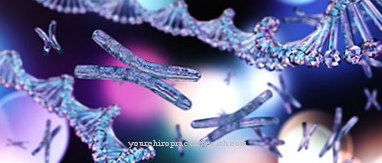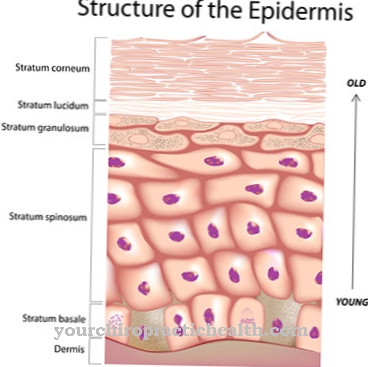At Hemangioblastoma are vascular neoplasms that occur in the central nervous system. The disease shows up in the majority of cases in young adults. In principle, hemangioblastomas are a benign form of tumors. The tumor is usually located in the cerebellum.
What is Hemangioblastoma?

© Gorodenkoff - stock.adobe.com
In principle is a Hemangioblastoma a special tumor that has a multitude of vessels. In most cases, the hemangioblastoma occurs in the area of the central nervous system. In addition, there is a possibility that the hemangioblastoma develops in the tissues of soft tissues.
According to the World Health Organization, hemangioblastomas are benign tumors. They are counted as grade 1 tumors of the central nervous system. In some cases, hemangioblastomas appear together with the so-called Hippel-Lindau syndrome. In addition, a sporadic occurrence of the tumors is possible.
Hemangioblastomas often appear in the area of the brain stem, cerebellum, or in the medulla of the back. In rare cases, the tumors also occur in the area of the cerebrum. In addition, it is possible for hemangioblastomas to form on the retina of the human eye. They are often called retinal angiomas.
However, this name is incorrect. Basically around ten percent of all tumors located in the back of the fossa are hemangioblastomas. In the majority of cases, the patients are between 20 and 40 years old at the time of the disease.
The disease occurs more often in men than in women. Hemangioblastomas are most common in the area of the cerebellar hemispheres or the cerebellar worm. Ten percent of all hemangioblastomas arise in the medulla of the back, only three percent in the brain stem.
causes
Currently, the exact causes for the formation of hemangioblastomas are still largely unclear. Basically, the tumors arise from the so-called pia mater and various pathological capillaries. There is currently insufficient research into why they develop into hemangioblastomas. In principle, around 80 percent of all hemangioblastomas occur sporadically, while around 20 percent occur together with Hippel-Lindau syndrome.
Symptoms, ailments & signs
Hemangioblastomas cause various symptoms, which primarily depend on the respective location. For example, cerebral symptoms such as ataxia or speech disorders are possible. Sometimes there is also a root compression syndrome or a spinal paraplegic syndrome.
Some hemangioblastomas produce the substance erythropoietin. This substance causes the red blood cells to multiply (medical term polycythemia). From a macroscopic point of view, 60 percent of the tumor is cystic and 40 percent solid. The tumor has a round shape and, due to the high proportion of fatty tissue, has a yellow color.
When examined under a microscope, capillaries with thin walls are visible. In addition, hyperplastic endothelial cells can be seen. Pericytes are enclosed by special stromal cells. Hemangioblastomas contain a large proportion of the substance reticulin. In the context of hemangioblastomas, mitoses do not occur, but in rare cases bleeding, necrosis and calcification are possible.
Hemangioblastomas in the spinal cord are often associated with a fluid sac. This is also known as syrinx and causes numerous symptoms. If the hemangioblastoma damages the cerebellum, symptoms such as dysmetria, gait ataxia, dizziness and dysdiadochokinesis can occur. If the hemangioblastoma is located in the brain stem, failure of the cranial nerves is often the result.
Diagnosis & course of disease
With regard to the diagnosis of hemangioblastomas, various examination-technical procedures come into consideration, the use of which is decided by the treating physician. In principle, imaging methods are of the greatest importance for the diagnosis of hemangioblastomas.
In radiology, hemangioblastomas usually appear as masses that absorb the contrast agent administered and are characterized by a pseudocystic shape. When performing computed tomography or magnetic resonance imaging, cystic, hypodense masses are found in 60 percent of cases. Only 40 percent of all hemangioblastomas are solid.
Renal cell carcinoma should be considered as part of the differential diagnosis. Because the corresponding metastases may resemble a hemangioblastoma. However, a mix-up can be prevented with the help of histological examinations.
Complications
A hemangioblastoma can cause various symptoms. As a rule, the symptoms and the further course of the disease depend heavily on the affected area. In most cases, however, there are disorders of coordination, concentration and also speech disorders. These can negatively affect the patient's everyday life.
Furthermore, those affected suffer from bleeding and calcification of the vessels. If the tumor penetrates into the cerebellum, it can lead to various restrictions in the cognitive processes. Dizziness or gait disorders often occur here. In the further course of the disease, without treatment, cranial nerves can also fail, resulting in restricted mobility or paralysis. The quality of life of the patient is reduced by the hemangioblastoma.
Typically, treating hemangioblastoma does not lead to further complications. In most cases, the tumor can easily be removed. Complications can arise when the tumor is removed late and the tumor has already affected or damaged other regions. In this case, life expectancy can be reduced. However, if the treatment is successful, there is no change in life expectancy.
When should you go to the doctor?
Immediate treatment must always be given for hemangioblastoma to prevent further complications and further spread of the tumor. If no treatment is initiated, the affected person can die of hemangioblastoma in the worst case. A doctor should be consulted if speech disorders occur for no particular reason.
Those affected may also suffer from impaired sensitivity or various sensory disorders, which can also indicate hemangioblastoma. Bleeding often occurs in the skin. Furthermore, dizziness or gait disturbances can indicate the disease and should always be examined if they persist over a long period of time. However, the severity of the complaints can vary greatly.
First and foremost, a pediatrician or general practitioner can be consulted with these complaints. The hemangioblastoma can then be diagnosed with the help of various examinations. Whether a direct removal is necessary, however, is decided depending on the severity of the tumor.
Doctors & therapists in your area
Treatment & Therapy
Hemangioblastomas can be treated relatively well, depending on the location and severity of the tumor. The remedy of choice is usually the removal of the tumor. The hemangioblastoma is removed as completely as possible in the course of a surgical procedure. It is important that the cyst wall is also completely removed.
The prognosis is then relatively positive. This is especially the case when it is a cellular subtype of hemangioblastoma. Sometimes it is difficult to differentiate hemangioblastoma from a secondary tumor in Hippel-Lindau disease. With a complete resection of the tumor, however, the prognosis is relatively favorable.
prevention
According to the current state of knowledge of medical and pharmacological research, no effective measures for the prevention of hemangioblastomas are known. Because the causes for the formation of this type of tumor are still largely unexplained.
For this reason, the timely diagnosis and treatment of hemangioblastoma play the most important role. In the case of characteristic complaints and symptoms, a suitable specialist should be consulted as soon as possible.
Aftercare
The treatment of cancer is always followed by follow-up care. Because there is a risk that a new tumor will develop in the same place. Doctors carry out follow-up care at least quarterly in the first year of diagnosis. Then the rhythm expands. If there is still no new formation in the fifth year, a one-year check is then due.
The patient receives detailed information about this. Follow-up care often takes place in the clinic of the first surgery. Imaging techniques such as MRI and CT are used to diagnose hemangioblastoma. In rare cases, the disease requires long-term follow-up care because consequential damage persists. These can be treated in various therapies.
A rehabilitation measure promises quick success. Here, experts from various fields are available and can adjust the patient specifically for everyday life. Appropriate medication can also be prescribed in this way. Neurological problems sometimes cause fundamental changes in life.
This can cause emotional stress. Psychotherapy then helps. It should be noted, however, that a hemangioblastoma is a benign tumor. Consequential damage that has an impact on everyday life is an exception.
You can do that yourself
With hemangioblastoma, those affected have no options for self-help. This tumor must always be treated by a doctor, which usually requires surgery or radiation.
Since the hemangioblastoma has a negative effect on the general well-being of the person concerned, the patient should rest and not subject the body to unnecessary stress. Bed rest and relaxation techniques can have a positive effect on the disease. Patients also need help and support from friends and family. Loving care also has a positive effect on the course of the disease. Possible psychological complaints can be addressed with the help of discussions. Children should also be fully informed about the possible course of this disease. In many cases, conversations with other affected persons or, in the case of severe emotional distress, conversations with a therapist also help, whereby an exchange of information can be very helpful.
Since an early diagnosis has a very positive effect on the course of the disease, an examination should be carried out at the first signs. Even after treatment, regular examinations are necessary in order to identify and treat other possible tumors at an early stage.



.jpg)

.jpg)







.jpg)

.jpg)
.jpg)











.jpg)